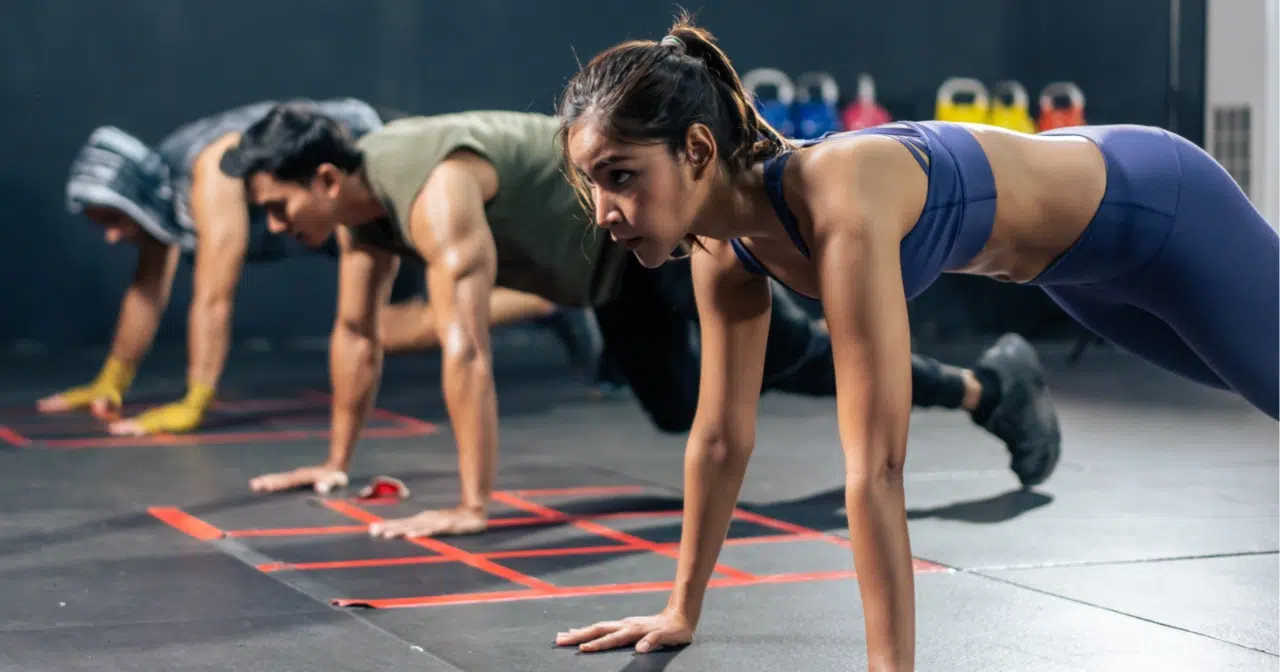Listen on: Apple Podcasts | Spotify
How does crawling as a toddler affect reading as a child? For that matter, could your core strength also affect your ability to read as an adult? And what impact could your posture, which affects the engagement of your core, have on reading and focus in your day-to-day life?
I pondered each of these questions after our grandson heard from one of his classmates that the longer a child crawls, the better he or she will be at reading. I hadn’t heard that before, but it sounded interesting to investigate. Could the muscles around your midsection impact the function of your mind? Here’s what I discovered.
The correlation between physical fitness and cognitive function has long been a subject of interest in the scientific community.1Chaddock, L., Erickson, K. I., Prakash, R. S., Kim, J. S., Voss, M. W., VanPatter, M., … & Kramer, A. F. (2011). A neuroimaging investigation of the association between aerobic fitness, hippocampal volume, and memory performance in preadolescent children. Brain Research, 1358, 172-183. As our understanding of the human body and mind continues to grow, it becomes increasingly clear that the two are intricately linked and that improving our physical well-being can positively impact our intellectual capabilities.2Tomporowski, P. D., Davis, C. L., Miller, P. H., & Naglieri, J. A. (2008). Exercise and children’s intelligence, cognition, and academic achievement. Educational Psychology Review, 20(2), 111-131. One aspect of this relationship that is gaining attention is the connection between core strength and reading abilities.
What does “core strength” mean?
Core strength refers to the stability and strength of the muscles surrounding the spine, pelvis, and torso.3Willardson, J. M. (2007). Core stability training: applications to sports conditioning programs. Journal of Strength and Conditioning Research, 21(3), 979-985. These muscles, which include the rectus abdominis, erector spinae, obliques, and the deep stabilizing muscles such as the transversus abdominis and multifidus, work in harmony to provide essential support for your body.4Hibbs, A. E., Thompson, K. G., French, D., Wrigley, A., & Spears, I. (2008). Optimizing performance by improving core stability and core strength. Sports Medicine, 38(12), 995-1008. A strong core is vital to maintain balance and proper posture which reduces injury risk.5Akuthota, V., & Nadler, S. F. (2004). Core strengthening. Archives of Physical Medicine and Rehabilitation, 85(3), S86-S92. Furthermore, core strength is crucial in virtually all daily activities, from sitting and standing to bending and lifting.
The core muscles are a central hub facilitating force transfer and movement between the upper and lower body.6Kibler, W. B., Press, J., & Sciascia, A. (2006). The role of core stability in athletic function. Sports Medicine, 36(3), 189-198. To gain an appreciation for their importance, imagine yourself picking up a grocery bag from the floor with a midsection made of rubber. Or what about throwing a ball from overhead? It wouldn’t be possible. Your core creates a stable connection between your ams and lower body, allowing you to move and lift and swing. A strong core can even amplify the force generated by your arms or legs. However, the benefits of core strength are not exclusive to athletes; individuals of all ages and fitness levels can experience improvements in daily activities and overall quality of life by focusing on core conditioning.
Beyond its stabilizing role, your core has a unique connection to your brain as well.
The Case for Crawling
Crawling is one of the most primal types of exercise we learn. The significance of crawling as a toddler has long been a topic of interest for developmental psychologists and educators. When a human (toddler or adult) crawls, they lift one hand off the floor while simultaneously lifting the knee on the opposite side of the body. This movement requires you to stabilize yourself with the muscles in your midsection so you remain balanced. Try it on the floor right now. You might find it difficult to crawl slowly and gracefully if you haven’t exercised consistently. If it’s easy, try pausing mid-crawl with one hand and the opposite knee above the floor. Can you hold yourself steady, with your torso parallel with the floor, or do you tip over?
Crawling is a crucial milestone in a child’s physical development and profoundly influences cognitive development. Crawling is essential in developing the brain’s neural connections, which are critical for a wide range of cognitive functions.7Kolb, B., & Gibb, R. (2011). Brain plasticity and behaviour in the developing brain. Journal of the Canadian Academy of Child and Adolescent Psychiatry, 20(4), 265-276. As toddlers crawl, they develop bilateral coordination, spatial awareness, and hand-eye coordination.8Williams, H. (2017). The importance of crawling for cognitive and physical development. Journal of Child Health Care, 21(1), 5-12. These skills are foundational for reading, as they aid in left-to-right eye tracking, an essential component of reading fluency and comprehension.
Bilateral Coordination and Reading
Bilateral coordination, or using both sides of the body simultaneously, helps develop fine motor skills necessary for tasks like holding a book, turning pages, and writing.9Dewey, D., Kaplan, B. J., Crawford, S. G., & Wilson, B. N. (2007). Developmental coordination disorder: associated problems in attention, learning, and psychosocial adjustment. Human Movement Science, 21(5-6), 905-918. Furthermore, bilateral coordination is essential for establishing neural pathways that connect the left and right hemispheres of the brain, which is critical for reading and language processing.10Gazzaniga, M. S. (2000). Cerebral specialization and interhemispheric communication: does the corpus callosum enable the human condition? Brain, 123(7), 1293-1326.
Vestibular System and Concentration
Crawling also helps develop the vestibular system responsible for balance, spatial orientation, and coordination.11Ayres, A. J. (2005). Sensory integration and the child. Western Psychological Services. This system is crucial for children’s ability to sit upright, focus on text, and maintain good posture while reading. Research has shown that children with well-developed vestibular systems are better equipped to concentrate and process information, leading to improved reading abilities.
Given the importance of crawling for both physical and cognitive development, parents and caregivers should provide ample opportunities for children to practice this skill. Encourage supervised floor time, create engaging environments with age-appropriate toys, and allow the child to explore their surroundings safely.
Some children move out of the crawling phase quickly, and while it’s exciting to see the child moving on two feet, the shortened crawling period can compromise core development and may affect reading skills in the future. Fortunately, children can develop core conditioning at any age, so even if they miss out on crawling, they can leverage exercise to condition their core and improve reading and learning. Adults can do the same!
Core Strength and Cognitive Function
Core strength has been shown to influence attention, focus, and concentration, which are all essential for effective learning and reading.12Moreau, D., Kirk, I. J., & Waldie, K. E. (2012). Seven pervasive statistical flaws in cognitive training interventions. Frontiers in Human Neuroscience, 6, 101. By promoting good posture and reducing fatigue, a strong core allows you to maintain better focus during reading and other cognitive tasks, ultimately contributing to improved academic performance and intellectual growth. This is a good reminder for me, too. I tend to start slouching as the day progresses rather than sitting up tall with good posture.
Research Support
Studies show regular exercise improves attention, memory, and executive functioning.13Hillman, C. H., Erickson, K. I., & Kramer, A. F. (2008). Be smart, exercise your heart: exercise effects on brain and cognition. Nature Reviews Neuroscience, 9(1), 58-65.,14Chaddock, L., Erickson, K. I., Prakash, R. S., Kim, J. S., Voss, M. W., VanPatter, M., … & Kramer, A. F. (2011). A neuroimaging investigation of the association between aerobic fitness, hippocampal volume, and memory performance in preadolescent children. Brain Research, 1358, 172-183. At this point, we shouldn’t be surprised that those who exercise regularly have better-functioning brains, including better cognitive function and emotional control. One proposed mechanism for this relationship is the increased blood flow to the brain during exercise, resulting in enhanced neural plasticity and the release of neurotrophic factors, which promote cognitive health.15Cotman, C. W., Berchtold, N. C., & Christie, L. A. (2007). Exercise builds brain health: key roles of growth factor cascades and inflammation. Trends in Neurosciences, 30(9), 464-472. But, that’s more of a general statement about all exercise. What might core strength and conditioning have to do with reading and other cognitive functions?
Several studies have found promising evidence for the relationship between core strength and reading ability. For example, in one study, children who participated in a physical exercise program, which included core-strengthening exercises, demonstrated significant improvements in reading skills compared to their peers in a control group.16Moreau, D., Kirk, I. J., & Waldie, K. E. (2012). Seven pervasive statistical flaws in cognitive training interventions. Frontiers in Human Neuroscience, 6, 101. This improvement was attributed to the positive effects of exercise on attention, focus, and concentration, which are essential for reading comprehension and retention.
Moreover, research has shown that good posture, supported by strong core muscles, can improve focus and concentration during reading tasks.17Mehta, R. K., Shortz, A. E., & Benden, M. E. (2015). Standing up for learning: A pilot investigation on the neurocognitive benefits of stand-biased school desks. International Journal of Environmental Research and Public Health, 13(1), 59. Poor posture can lead to discomfort and fatigue, which may hinder an individual’s ability to maintain attention during cognitive tasks, such as reading. By strengthening core muscles and promoting proper posture, individuals can better maintain their focus, leading to enhanced reading abilities.
Posture
Maintaining proper posture while reading is essential for optimal focus and concentration. A well-aligned spine and engaged core muscles help support the body and reduce the strain on the neck, shoulders, and back.18Kuo, Y. L., Tully, E. A., & Galea, M. P. (2009). Video analysis of sagittal spinal posture in healthy young and older adults. Journal of Manipulative and Physiological Therapeutics, 32(3), 210-215. By reducing discomfort and fatigue, a strong core and good posture allow readers to maintain their attention and better process the information they are reading. In this way, core strength directly contributes to improved reading abilities by facilitating the physical and cognitive conditions necessary for effective learning. Again, this is a good reminder for me.
Techniques to Improve Core Strength and Reading Skills
As I mentioned above, your core holds your upper and lower body together. If it’s weak, you won’t be able to hold a weighted bar on your shoulders to do squats, deadlifts, or even be able to do heavy bicep curls or tricep pressdowns. As such, you can develop significant core strength simply by doing these movements with progressively heavier weights. As your arms and legs get stronger, so, too, will your core. I bring this up because people often think they must spend significant time and effort doing core work. A little is fine, but if it interferes with the time you could be doing heavy compound exercises, you’ll compromise the benefits of your workouts.
With that said, I do think that starting your training sessions with some core work is valuable. I even do that when I take our eight-year-old grandson through a workout.
Exercise Ideas
Some effective core exercises for kids include:
- Plank variations (e.g., standard plank, side plank, walking plank)
- Supermans or back extensions
- Sit-ups
- Catch with a weighted ball, thrown by twisting, swinging, or throwing with both hands from overhead.
Kids learn quickly, which means they learn poor technique if not properly taught, just as fast as they learn good technique when they’re shown the right way. It’s essential to take the time to teach them good form. Even something as simple as a pushup, when executed properly, can be great for developing core stability.
Adults can benefit from the same exercises I covered for kids, but as they increase their strength, may want to add in some other options, such as:
- Dead bugs
- Russian twists
- Barbell rollouts
- Dynamic planks
- Hanging knees to elbows
The list is almost endless. And remember, the harder you train with weights, the more of your core you’ll use to stabilize yourself, which means you can train your core pretty hard while you’re focused on strengthening other parts of your body. In my online personal training programs, I’ll include some core exercises over a week of training, but most of the exercises are compound movements that involve the core anyway.
Other forms of exercise or sport can also train your core well, such as:
- Yoga
- Pilates
- Martial arts
- Track and field (especially sprinting and jumping)
- Gymnastics
Summary
When talking with clients about their nutrition, I often remind them that their nutrition changes don’t need to be just for them. They can be for the whole family. What’s healthy for adults is usually healthy for kids, and vice versa. The same could be said about exercise and core strength development. You might want to use this information to improve your kids’ physical and mental health, but if you join them in the activities, you’ll gain similar benefits. You just have to commit and be consistent.
Other factors beyond the development of your core affect how well you read. Some are not within your control. This factor is. Of course, you can’t become a better reader if you don’t read consistently, any more than you can get fit and healthy without exercising consistently. If you need something new to read, I strongly recommend my new book, The 3 Pillars of Vigor: Essential Habits for Exceptional Health and Fitness.
Photo by Jonathan Borba on Unsplash



